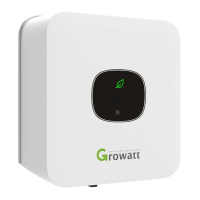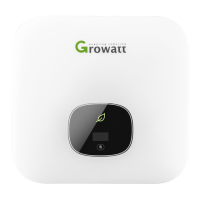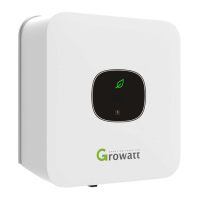Do you have a question about the Growatt MIC 3300 TL-X and is the answer not in the manual?
Manual applicability and scope.
Intended audience and their qualifications.
How to find more details and disclaimers.
Explanation of warning symbols used in the manual.
Symbols and labels found on the inverter itself.
Specifies authorized operational purposes of the inverter.
Requirements for personnel handling the inverter.
General safety precautions for installation and operation.
Precautions during inverter assembly and mounting.
Safety guidelines for electrical connections.
Safety precautions during inverter operation.
General overview and components of the MIC TL-X inverter.
Details and meaning of information on the inverter's type label.
Physical dimensions and weight specifications.
Guidelines for storing the inverter before installation.
Key features and benefits of the inverter.
Safety precautions specific to the installation process.
Guidance on choosing a suitable place to install the inverter.
Steps and considerations for physically mounting the inverter.
Instructions for securely attaching the inverter to a wall.
Electrical safety precautions before making connections.
Procedure for connecting the AC output cable.
Requirements for an additional protective earth connection.
Procedure for connecting the solar panel array.
How to connect communication and signal cables.
Instructions for properly grounding the inverter.
Setup for power control using external devices.
Step-by-step guide for PV array connection.
Details of pin configuration for DRMS connection.
How to configure DRMS modes via pin connections.
Specifics on using DRMS functionality in European regions.
Explanation of the Arc-Fault Circuit Interrupter function.
Specific hazards related to AFCI and electric arcs.
Steps for operating or troubleshooting the AFCI.
Procedures for initiating inverter operation.
Basic configuration options for the inverter.
Accessing and modifying advanced inverter parameters.
Methods for communicating with and monitoring the inverter.
How to manage PQRM settings.
Verifying system configurations.
Setting the current date and time on the inverter.
Configuring power output limits and sensors.
Restoring the inverter to its default factory settings.
Modifying settings based on regional defaults.
Step-by-step guide to powering on the inverter.
Procedure for safely powering down the inverter.
Ensuring proper cooling and addressing overheating issues.
Instructions for cleaning the inverter's exterior.
How to inspect and maintain the DC isolator.
Understanding and resolving error messages shown on the display.
Troubleshooting common system-related faults.
Interpreting and resolving inverter warning codes.
Diagnosing and fixing inverter-specific faults.
Steps for safely removing the inverter from its installation.
Guidelines for packing the inverter for transport or storage.
Recommended conditions for storing the inverter.
Proper methods for environmentally sound disposal.
Detailed technical specifications of the inverter models.
Information on inverter connectors and their types.
Recommended torque values for various screws and terminals.
List of optional accessories available for the inverter.
| Model | MIC 3300 TL-X |
|---|---|
| Rated Power | 3300 W |
| Max. Output Power | 3300 W |
| Max. DC Voltage | 550 V |
| Max. PV Input Voltage | 550V |
| Start Voltage | 80 V |
| Start-up Voltage | 80 V |
| Nominal DC Voltage | 360 V |
| Number of MPPT | 1 |
| Number of MPP Trackers | 1 |
| Max. Input Current per MPPT | 12.5 A |
| AC Nominal Power | 3300 W |
| Max. AC Apparent Power | 3300 VA |
| Nominal AC Voltage | 230 V |
| Rated Output Voltage | 230 V |
| AC Voltage Range | 180 V - 280 V |
| AC Grid Frequency | 50 Hz / 60 Hz |
| Output Frequency | 50/60 Hz |
| Max. Output Current | 15 A |
| Power Factor | >0.99 |
| THDi | <3% |
| THD | <3% |
| Efficiency | 97.6% |
| DC Connection | MC4 |
| AC Connection | Plug |
| Protection Degree | IP65 |
| Topology | Transformerless |
| Operating Temperature Range | -25°C to +60°C |
| Weight | 10.8 kg |
| Cooling Method | Natural convection |
| Dimensions (W / H / D) | 375 / 350 / 160 mm |
| Max. Input Power | 4620W |











